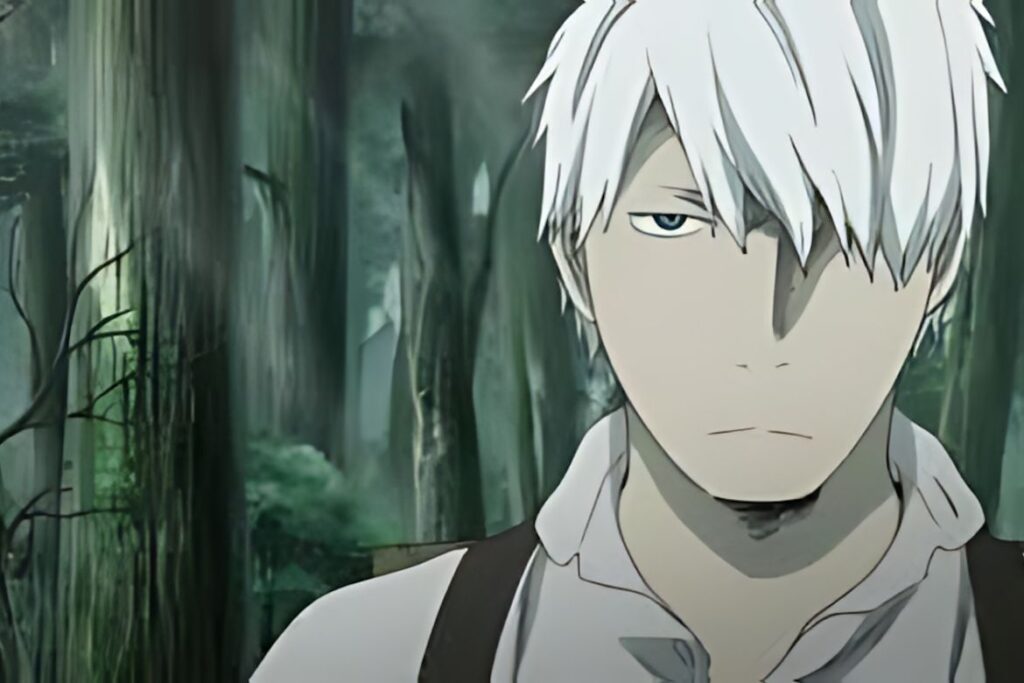Table of Contents
Have you ever been mesmerized by the beauty of the unseen world? Mushishi is one such anime that takes you on a mysterious journey into a realm where the ordinary and the supernatural coexist in harmony. With its tranquil pace, stunning visuals, and profound storytelling, Mushishi is a masterpiece that has left a lasting mark on the anime world. If you’re looking for something different from the typical action-packed, fast-paced anime, Mushishi might be exactly what you need.
What is Mushishi?

Mushishi is a unique blend of supernatural, fantasy, and slice-of-life genres. It explores the concept of “Mushi,” ethereal, spirit-like beings that exist in a realm beyond human understanding. Unlike most anime, Mushishi is not driven by an overarching plot but is a collection of standalone stories, each filled with mystery, reflection, and emotional depth. The anime’s calm, philosophical tone makes it a rare gem in anime.
Story of Mushishi

The story of Mushishi revolves around Ginko, a wandering “Mushishi” (a Mushi master) who travels from village to village to investigate and solve problems caused by Mushi. Each episode introduces a new, self-contained tale where Ginko interacts with locals affected by Mushi whether it’s a strange disease, an unexplained natural phenomenon, or a supernatural occurrence. Through his encounters, viewers gain insight into the mysterious world of Mushi and the delicate balance between humans and nature.
Character Development
The heart of Mushishi is its protagonist, Ginko. He’s a calm, knowledgeable, and empathetic man with a mysterious past. Unlike conventional anime protagonists, Ginko’s goal is not to become stronger or defeat a great enemy. Instead, his journey is one of understanding and coexisting with the unknown. His unique appearance, characterized by white hair and a single green eye, reflects his deep connection with the Mushi world. While most of the supporting characters only appear for one episode, their personal stories are often emotionally impactful and leave a lasting impression on the audience.
Release Information

mushishi anime character
Mushishi first aired in October 2005 and concluded in June 2006 with a total of 26 episodes. Later, a second season, Mushishi: Zoku Shou, was released in two parts, from April 2014 to December 2014. The anime also includes a special episode called Mushishi: Hihamukage and a movie titled Mushishi Zoku Shou: Suzu no Shizuku, which served as a fitting conclusion to the series.
6. Manga Connection

Mushishi is based on the manga written and illustrated by Yuki Urushibara. The manga ran from 1999 to 2008 and received multiple awards for its originality and storytelling. While the anime adaptation stays faithful to the source material, the manga provides a deeper look at certain aspects of the world and characters. Fans of the anime are often encouraged to read the manga to experience a richer, more nuanced version of the story.
5 Good Points of Mushishi

- Unique Atmosphere and Aesthetics: The anime’s calm, meditative ambiance is unlike anything found in mainstream anime. Each episode feels like a work of art.
- Beautiful Animation and Art Style: The hand-drawn visuals perfectly capture the beauty of nature and the mysterious world of Mushi.
- Thought-Provoking Themes: Every episode explores deep themes of humanity’s relationship with nature, balance, and the unknown.
- Memorable Soundtrack and Sound Design: The background music and natural sounds (like birds chirping and rustling leaves) immerse viewers in the world of Mushishi.
- Emotional Storytelling: Despite its episodic format, each story resonates with raw emotion, often leaving a lasting impact on the viewer’s heart.
5 Bad Points of Mushishi
- Slow Pacing: The anime’s slow, reflective pace may not appeal to those seeking fast action or high-energy scenes.
- Episodic Structure: Since each episode is self-contained, viewers who prefer an ongoing plotline may find it difficult to stay engaged.
- Lack of Action: Fans of battle-centric anime may feel underwhelmed due to the absence of traditional fight scenes.
- Minimal Character Growth: While Ginko’s character remains steady, he doesn’t undergo significant development, as he’s more of an observer than an active participant.
- Niche Appeal: The anime’s focus on philosophy and slow storytelling isn’t for everyone, making it a “love it or leave it” experience.
Who Should Watch Mushishi
If you enjoyed anime like Natsume’s Book of Friends, The Ancient Magus’ Bride, or Mononoke[this anime also watch] then Mushishi will likely captivate you. These shows share similar themes of mystical encounters, slow pacing, and deeply emotional storytelling. If you love anime that invites you to reflect on life, nature, and humanity’s relationship with the unseen world, Mushishi is a must-watch.
Review and Rating
Mushishi is widely regarded as one of the most artistic and philosophical anime ever made. The show’s visual storytelling, deep themes, and hauntingly beautiful sound design make it a standout experience. However, its slow pace and episodic nature may not be for everyone. For those seeking action-packed thrillers, Mushishi might feel too slow. But for those who value introspection and emotional depth, it’s a near-perfect anime. Rating: 9/10 a masterpiece of subtle beauty and profound storytelling.
Where to Watch Mushishi
Depending on your region, Mushishi can be streamed on platforms like Crunchyroll, Funimation, and Hulu. It’s also available on services like Amazon Prime Video and Blu-ray collections for those who prefer physical copies.
Conclusion
Mushishi is not just an anime it’s an experience. Its quiet storytelling, thought-provoking themes, and breathtaking visuals make it a masterpiece for those willing to immerse themselves in its world. While its slow pace and episodic nature may not suit every viewer, those who appreciate calm, reflective anime will find Mushishi unforgettable. Whether you love it or not depends on your taste. If you’re open to a journey of quiet beauty and introspection, then Mushishi is undoubtedly worth your time.
mushishi.fandom.com | Myanimelist




